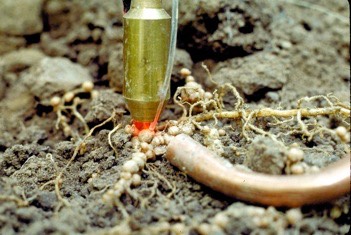
Sanctions apparently involve host control of oxygen supply to the nodule interior, which can be monitored by changes in the absorbance of red light by a nodule-specific hemoglobin.
Rhizobia are bacteria that spend most of their lives in soil, but they are better known for their work inside legume root nodules (see photo), where they convert atmospheric nitrogen to forms their plant hosts can use. Students in Ford Denison’s lab have used this legume-rhizobia symbiosis as a model to study the evolution of cooperation.
When cooperative, nitrogen-fixing strains share an individual plant with “cheater” strains – strains that divert too many resources from nitrogen fixation to their own reproduction – we might expect cheaters to produce more offspring and displace cooperators within a few generations (Denison 2000; West et al. 2002). Such “tragedies of the commons” are widespread in human societies, leading to depletion of ocean fisheries, global warming, unsustainable population growth, and financial crises. But, unlike complacent financial regulators, legume plants often impose “sanctions” on cheaters, which reduce their reproduction to less than that of cooperative, nitrogen-fixing strains (Kiers et al., 2003; Oono et al., 2011). Sanctions haven’t eliminated cheaters entirely, however. We are still trying to find out why.
When a legume host is abundant, rhizobia in nodules may outnumber those in soil. But hosts may not be available every month -- or every year. Rhizobia in the nongrowing "persister" state can survive for over a year without food, especially if they start with abundant resources. When starved, rhizobia "hedge their bets" by dividing into two daughter cells. One daughter gets most of the stored resources and becomes a persister; the other gets few resources but retains the ability to grow (Ratcliff and Denison, 2010).
Future work in the Denison lab will focus on neglected phases of the rhizobial life cycle, such as escape from nodules and survival in soil, and how these phases may undermine or reinforce the effects of host sanctions (Denison and Kiers, 2011).
Literature Cited:
Denison R. F. 2000. Legume sanctions and the evolution of symbiotic cooperation by rhizobia. American Naturalist 156:567-576.
Denison R. F., E. T. Kiers. 2011. Life-histories of rhizobia and mycorrhizal fungi. Current Biology 21:R775-R785.
Kiers E. T., R. A. Rousseau, S. A. West, and R. F. Denison. 2003. Host sanctions and the legume-rhizobium mutualism. Nature 425:78-81.
Oono R., C. G. Anderson, and R. F. Denison. 2011. Failure to fix nitrogen by non-reproductive symbiotic rhizobia triggers host sanctions that reduce fitness of their reproductive clonemates. Proceedings of the Royal Society B 278:2698-2703.
Ratcliff W. C., R. F. Denison. 2010. Individual-level bet hedging in the bacterium Sinorhizobium meliloti. Current Biology 20:1740-1744.
West S. A., E. T. Kiers, E. L. Simms, and R. F. Denison. 2002. Sanctions and mutualism stability: why do rhizobia fix nitrogen? Proceedings of the Royal Society B 269:685-694.
